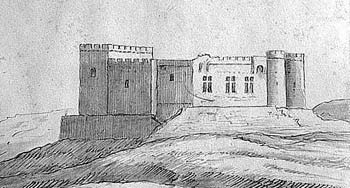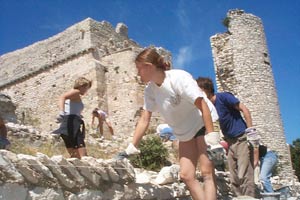|
History of the castle

The more ancient
known act concerning Thouzon dates from 1014: It attributes to the
Benedictines of St Andrew of Villeneuve (near Avignon) the ownership
of « churches which are or will be on Thouzon's mountain,
with their outbuildings. »
In 1088, the Count of Toulouse, marquees of Provence, confirms this
ownership. But this act mentions that the marquis keeps for himself
the albergue[1] and the right to go there with an army.
In 1096, Pope Urbain II confirms Thouzon's ownership by the abbey
of St Andrew by just mentionaing St Peter of Thouzon.
In 1118, Pope Gelase II grants new privileges to St Peter of Thouzon.
In 1140, an act mentions again 2 churches St Mary’s and St
Peter’s, but also the woods, the adjacent village and all
the territory with the swamp, the fishes and the banks.
In 1171, in spite of the property of the Benedictines, the Count
of Toulouse Raymond V asks Giraud Amic to strengthen Thouzon, but
he keeps over the future castle the high sovereign power, the rights
of justice, cavalcade[2] and albergue. This act mentions
the « monasterio » while in 1202, they call it the «
castro ».
1396: The castle is occupied by the soldiers of the Viscount of
Turenne. The vice-chancellor Gaston de Montecatino chases them away.
1549: A frontdoor stone showing the arms of the abbot François
de Castellane indicates a likely restoration of the castle.
1563: The Baron of the Adrets chief of some groups of huguenots
comes into the Thouzon’s place.
1594: César de Brancas, abbot of St Andrew and Lord of Thouzon,
makes some repairs on the castle (Archives of Vaucluse).
1696: The abbot of Thouzon sells the castle and the lands to Joseph
de Martin, archivist and secretary of state.
1700, 1705, 1727: Works are done on the roof of St Mary’s
church.

1987: Birth of the association of
Thouzon’s site.
[1] Albergue :
privilege which forces the vassal to offer
board and lodging to his lord once a year.
[2] Cavalcade
: privilege of the lord
to take men and animals to complete his army.
|






